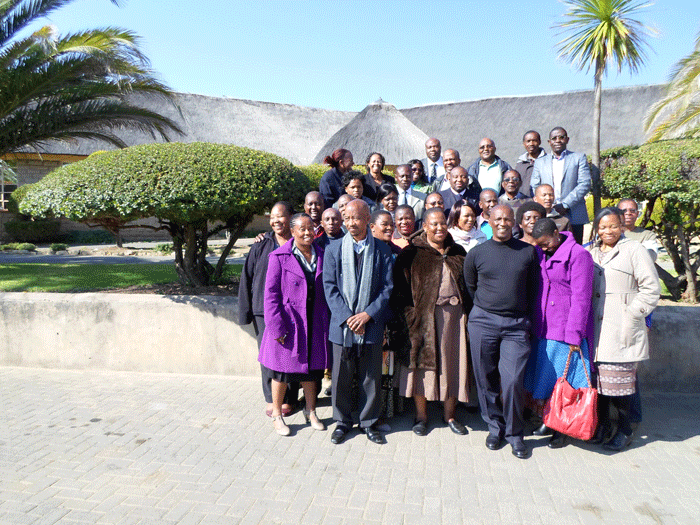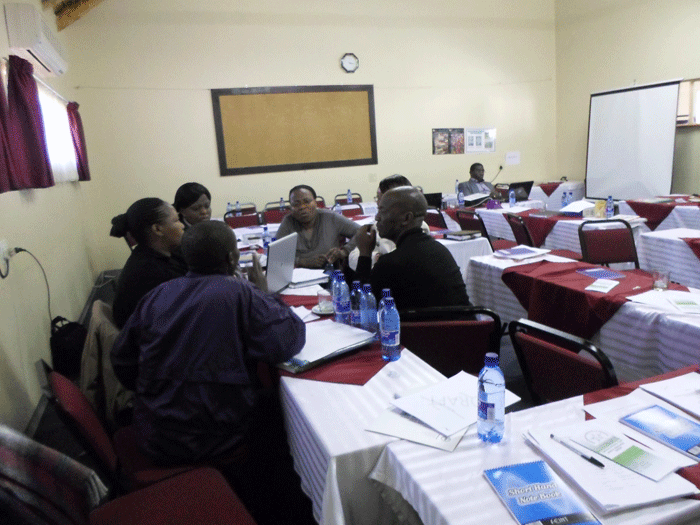
Lesotho National Plant Genetic Resources Centre

Background
The Lesotho National Plant Genetic Resources Centre has been an integral part of the Natural Resources Management Program under the Department of Agriculture Research (DAR) of the Ministry of Agriculture and food Security (MAFS). Under portfolio of the Ministry of Agriculture and Food Security, the NPGRC has to comply with the Ministry priority activities that emphasize promotion of low cost agricultural technologies for the benefit of farmers. The NPGRC is expected to promote on farm conservation activities for the benefit of farmers.

The Lesotho National Plant Genetic Resources Centre undertakes a number of activities including multiplication and charac terization activity, maintain the medicinal plants field genebank and in collaboration with Lesotho Highlands Water Project and Katse Botanical Garden started in - situ conservation activities in two pilot areas. One multi-crop collecting expedition was also executed.
Objectives
The objective of the Lesotho National Plant Genetic Resources Centre (NPGRC) is to carry out activities aimed at promoting the conservation and sustainable utilization of plant genetic resources for food and agriculture. To support this objective, the NPGRC:
- Undertakes collection missions for indigenous plant genetic resources important for food and agriculture;
- Multiplies and regenerates plant genetic resources;
- Characterizes and evaluates plant genetic resources;
- Conserves germplasm in the national ex-situ genebank;
- Conserves germplasm in the national field genebank.
Activities
Collections
Collections
The objectives of the collection missions are to collect and conserve germplasm of multicrop species, To collect germplasm of land races of crop species, to collect local indigenous knowledge pertaining to the landraces collected and to collect information on the extent of genetic diversity and erosion on the land races.
Collection missions are usually undertaken after the winter harvest. Seeds are collected from farm stores. As many villages as possible are visited during the collecting expeditions. Farmers are requested to donate the landraces they have, in the amount they can afford to donate. Germplasm is collected using cloth and paper bags where the tags are placed both inside and outside the bag bearing the collectors number, date of collection, village and name of the collected variety. Global Positioning Systems (GPS) are used to collect the information on the collection location that is the altitude, longitude and latitude. SPGRC collecting forms are used to collect information on the germplasm collected and the indigenous knowledge on the germplasm. Additional information is recorded on field notebooks.
Horses are used where need arises to cover villages which are not accessible by road transport.
Material
Storage, Handling and Distribution
Multiplication and Characterization
The collected seed samples are cleaned, dried and tested for viability before sealing them in aluminum foils and kept in domestic deep freezers at -180C in the active collection of the NPGRC and duplicate samples with adequate amount of seed are sent to SPGRC for storage in the base collection.
Multiplication and Characterization
Obtain sufficient seed for storage at the National and Regional gene bank Generate characterization data for the above accessions to increase their value for utilization The accessions collected during 2003/04 generally have inadequate seed for active and base collections. In order to meet the requirements of both the NPGRC and SPGRC collections, the seed quantities of all accessions with insufficient seed must be increased through multiplication In addition, the same accessions must be characterized to generate descriptive data.
Field Genebanks
Popularity of medicinal plants continues as evidenced by mushrooming street markets in all the big towns. The socio-economic importance attached to medicinal plants in this country cannot be over emphasized. Medicinal plants are a source of income for many households as well as playing a major role in cultural issues.
Current Status
The Lesotho National Plant Genetic Resources Centre developed a Medicinal Plants Field Gene bank at the Agricultural Research Main Station in Maseru. The Field Gene Bank is in its fourth year of development since its establishment during 2000/2001. The Field Gene Bank is well fenced and thus does not encounter such as trespassing.
The Field gene bank currently has 75 species that are adapting to the new location. These plant species include medicinal plants, which are endemic to Lesotho, rare, and those that are highly threatened in the wild due to their high demand in the local market. One major threat to these valuable plant species is harvesting without replacement, which justifies the need for more concerted conservation efforts and more awareness campaigns.
In Situ Conservation
Participatory in-situ conservation of plant genetic resources
 In line with the conservation development plan for the Lesotho Highlands Water Project (LHWP), a collaborative effort between the NPGRC and the project in identifying possible areas for in-situ conservation resulted in identification of two sites. This was done in partnership with the local communities to promote conservation and sustainable use of the existing vegetation. This particularly is a joint effort between the NPGRC and Katse Botanical Garden under the umbrella of the LHWP. The two sites are namely the Ha Ncunyane and Bolahla villages. Both sites are potential habitats for a variety of wild species including mainly medicinal plants and other plants with a socioeconomic importance.
In line with the conservation development plan for the Lesotho Highlands Water Project (LHWP), a collaborative effort between the NPGRC and the project in identifying possible areas for in-situ conservation resulted in identification of two sites. This was done in partnership with the local communities to promote conservation and sustainable use of the existing vegetation. This particularly is a joint effort between the NPGRC and Katse Botanical Garden under the umbrella of the LHWP. The two sites are namely the Ha Ncunyane and Bolahla villages. Both sites are potential habitats for a variety of wild species including mainly medicinal plants and other plants with a socioeconomic importance.Documentation
National Plant Genetic Resources Committee (NPGRCom)
Dr Lefulesele Lebesa - Chairperson
Ms M Mohloboli - Secretary
Staff
Ms Matsikoane Motloli - Curator
Data of all the accessions at the NPGRC is registered into the SDIS database. Data registered include that related the species, their conservation status, geographical distribution, usage and the indigenous knowledge associated with them. It also seeks to promote public awareness of the importance of conserving genetic resources and their sustainable utilization.
National Plant Genetic Resources Committee (NPGRCom)
Dr Lefulesele Lebesa - Chairperson
Ms M Mohloboli - Secretary
Staff
Ms Matsikoane Motloli - Curator
Contacts
Department of Agricultural Research
P O Box 829,
P O Box 829,
MASERU,
Lesotho
Tel: +266 22 312395/326042
Fax: +266 22 310362
Email: This email address is being protected from spambots. You need JavaScript enabled to view it. (Matsikoane Sefotho - Curator)
Tel: +266 22 312395/326042
Fax: +266 22 310362
Email: This email address is being protected from spambots. You need JavaScript enabled to view it. (Matsikoane Sefotho - Curator)

